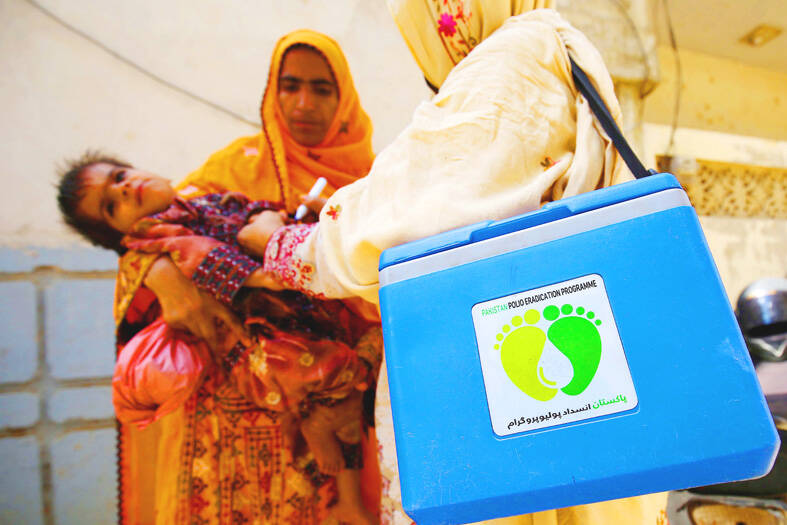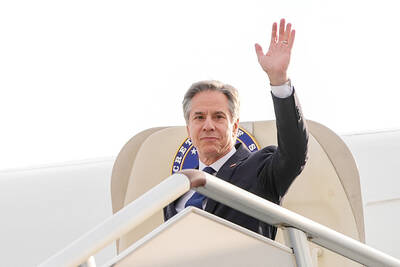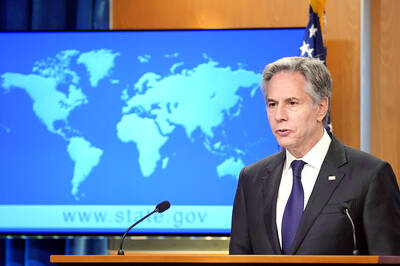Some of the world’s leading makers of flu vaccines say they could make hundreds of millions of bird flu shots for humans within months if a new strain of avian influenza jumps across the species divide.
One outbreak of avian flu known as H5N1 clade 2.3.4.4b has killed record numbers of birds and infected mammals.
However, human cases remain very rare and global health officials have said the risk of transmission between humans is still low.

Photo: EPA
Three vaccine manufacturers, GlaxoSmithKline PLC, Moderna Inc and CSL Seqirus — owned by CSL Ltd — are already developing or about to test sample human vaccines that better match the circulating subtype, as a precautionary measure against a future pandemic, executives at the companies said.
Others, such as Sanofi, said they “stand ready” to begin production if needed, with existing H5N1 vaccine strains in stock.
There has also been a push among companies to develop a bird flu vaccine for poultry, a market potentially far larger than that for humans.
However, less reassuring is that most of the potential human doses are earmarked for wealthy countries in long-standing preparedness contracts, global health experts and the companies said.
Many countries’ pandemic plans say flu shots should go first to the most vulnerable while supply is limited.
However, during the COVID-19 pandemic, many vaccine-rich countries inoculated large proportions of their populations before considering sharing doses.
“We could potentially have a much worse problem with vaccine hoarding and vaccine nationalism in a flu outbreak than we saw with COVID,” said Richard Hatchett, chief executive officer of the Coalition for Epidemic Preparedness Innovations, which helps fund vaccine research.
An international framework for pandemic flu allocates 10 percent of global supply for the WHO to share with low and middle-income countries.
By contrast, the WHO is seeking guarantees of 20 percent of the global supply for other types of pandemic in the wake of COVID-19.
The WHO has signed legally binding agreements with 14 manufacturers for 10 percent of their pandemic flu vaccine “as it comes off the production line,” in a mix of donated doses and doses to be bought by the agency at an affordable price, it said.
The agreements include six of the largest seasonal flu manufacturers, such as GlaxoSmithKline, Sanofi and CSL Seqirus, the WHO said.
The WHO did not comment on the potential for vaccine hoarding in a flu pandemic, but said mechanisms were being developed “so that countries can work together — not in competition with each other” to respond to such a crisis.
It is “fully confident” that manufacturers and member states would meet their obligations, it added.
In a pandemic, vaccine manufacturers would shift production of seasonal flu vaccines and instead make shots tailored to the new outbreak when needed. They already have the capacity to make hundreds of millions of doses.
Many of the potential pandemic shots are preapproved by regulators, based on data from human trials that show the vaccines are safe and prompt an immune response, a process already used with seasonal flu vaccines.
This means they might not require further human trials, even if they have to be tweaked to better match whichever strain does jump to humans. Data on how well the vaccines actually protect against infection would be gathered in real time.
There are close to 20 licensed vaccines against the H5 strain of flu, the WHO said, adding that existing antiviral treatments for people already infected would help mitigate the effects.
However, moving to large-scale production of a more targeted shot could take months, the manufacturers said.
Some potential shots use a traditional method, growing the virus used in the vaccines in chicken eggs over four to six months, they said.
“Creating the first dose is the easiest,” CSL Seqirus head of global medical strategy Raja Rajaram said. “The hardest is manufacturing in large quantities.”
Moderna’s mRNA vaccine research began with pandemic flu, and was modified for COVID-19, Moderna executive director of infectious diseases Raffael Nachbagauer said.
The company plans to launch a small human trial of an mRNA pandemic flu vaccine tailored to the new avian influenza subtype in the first half of this year, he said, adding that Moderna could respond “very quickly” in an outbreak scenario.

‘IN A DIFFERENT PLACE’: The envoy first visited Shanghai, where he attended a Chinese basketball playoff match, and is to meet top officials in Beijing tomorrow US Secretary of State Antony Blinken yesterday arrived in China on his second visit in a year as the US ramps up pressure on its rival over its support for Russia while also seeking to manage tensions with Beijing. The US diplomat tomorrow is to meet China’s top brass in Beijing, where he is also expected to plead for restraint as Taiwan inaugurates president-elect William Lai (賴清德), and to raise US concerns on Chinese trade practices. However, Blinken is also seeking to stabilize ties, with tensions between the world’s two largest economies easing since his previous visit in June last year. At the
Nearly half of China’s major cities are suffering “moderate to severe” levels of subsidence, putting millions of people at risk of flooding, especially as sea levels rise, according to a study of nationwide satellite data released yesterday. The authors of the paper, published by the journal Science, found that 45 percent of China’s urban land was sinking faster than 3mm per year, with 16 percent at more than 10mm per year, driven not only by declining water tables, but also the sheer weight of the built environment. With China’s urban population already in excess of 900 million people, “even a small portion

UNSETTLING IMAGES: The scene took place in front of TV crews covering the Trump trial, with a CNN anchor calling it an ‘emotional and unbelievably disturbing moment’ A man who doused himself in an accelerant and set himself on fire outside the courthouse where former US president Donald Trump is on trial has died, police said yesterday. The New York City Police Department (NYPD) said the man was declared dead by staff at an area hospital. The man was in Collect Pond Park at about 1:30pm on Friday when he took out pamphlets espousing conspiracy theories, tossed them around, then doused himself in an accelerant and set himself on fire, officials and witnesses said. A large number of police officers were nearby when it happened. Some officers and bystanders rushed

Beijing is continuing to commit genocide and crimes against humanity against Uyghurs and other Muslim minorities in its western Xinjiang province, U.S. Secretary of State Antony Blinken said in a report published on Monday, ahead of his planned visit to China this week. The State Department’s annual human rights report, which documents abuses recorded all over the world during the previous calendar year, repeated language from previous years on the treatment of Muslims in Xinjiang, but the publication raises the issue ahead of delicate talks, including on the war in Ukraine and global trade, between the top U.S. diplomat and Chinese